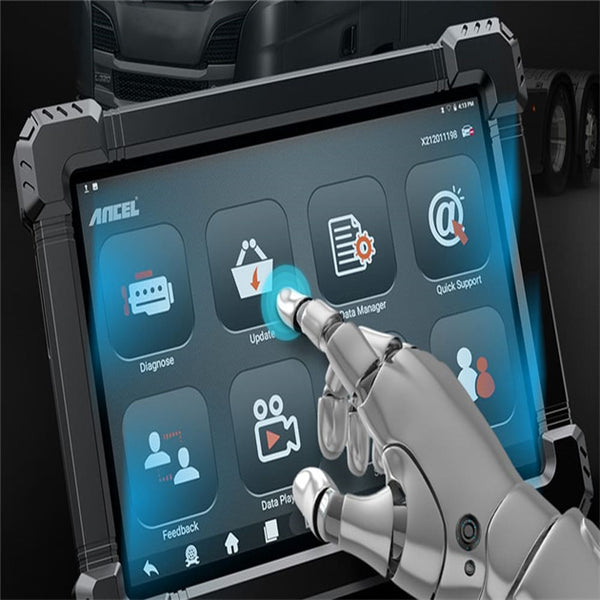Troubleshooting issues with ABS systems is an important function of car scanner diagnostic.
They are sometimes referred to as live data monitors, and these machines help mechanics make accurate diagnoses of vehicle problems.
Technicians will need a scanner tool to detect fault codes; particularly ABS fault codes such as sensor malfunctions or hydraulic pump failures.
Real-time data allows rapid identification of the main cause, significantly accelerating the repair process.
In addition, bluetooth obd2 reader can be used to test ABS components, thus ensuring their proper functioning after repairs.
These devices prove necessary for maintaining vehicle performance, making them a must-have in all garages that deal with automobiles.
Benefits Of Using A Code Scanner For ABS Troubleshooting
- Efficient Diagnostics:
Car readers simplify the diagnostic process of ABS problems by swiftly and accurately identifying faults.
You don't need to worry about manual troubleshooting because these scanners have an intuitive interface that saves time and energy.
By immediately placing the root causes of ABS malfunctions, code scanners empower users to solve problems before they worsen, thus keeping vehicles safe.
- Comprehensive Analysis:
Code Scanners' main advantage lies in their ability to offer detailed analysis of various aspects of ABS systems.
These scanners will inform you about your wheel speed sensors, hydraulic valves, and control modules, which will tell you more about their state of health.
Users can understand acti-time data and DTC users so that they can perform proper repair and maintenance on ABS systems.
- Cost-effective Solutions:
The OBD2 code scanner is a cheaper way to diagnose the problem with your car's anti-lock brake system (ABS).
This helps prevent costly repairs or car breakdowns through early detection. In addition, these code scanners will also identify ones that need replacement, saving users time and money.
The proactive approach prevents unwanted expenses from being spent fixing cars as it maintains them optimally.
- Enhanced Safety:
A fully functioning ABS is important for road safety, especially in emergency-stopping conditions.
In this regard, code scanners play a significant role in detecting issues that could compromise the ABS's braking performance.
They also assist in preventing accidents related to defects associated with sensor malfunctions within the ABS, such as valves or control modules.
- Long-term Maintenance
Regular scanning and monitoring using code scanners is paramount for long-term care of Anti-Lock Brake Systems (ABS).
By checking on them regularly but not waiting until they deteriorate into major failures, it is possible to avoid some complications that may lead to replacing expensive parts within the unit.
Therefore, frequent use of code scanners during maintenance checks increases reliability and leads to longer-lasting service life while avoiding any unexpected issues or high costs, followed by the vehicle’s better performance over time.
Related Reading: The Ancel OBD2 Scanner - Your Gateway to Peak Car Performance!
How To Troubleshoot ABS System Issues with a Code Scanner?
- Understanding ABS System:
To successfully fix problems, it is important to understand the ABS.
In emergency braking cases, the anti-lock brake system (ABS) is a safety feature that prevents wheels from skidding.
The main parts of this design are wheel speed sensors, hydraulic valves, a pump, and the control module for ABS.
These sensors determine how fast each wheel rotates and send this information to the ABS control module, which adjusts brake pressure accordingly to avoid skidding.
- Connecting the Code Scanner:
The proper connection of the obd2 code scanner should be the first thing used in the troubleshooting procedure.
Just plug your scanner for a car into the OBD-II port under your dashboard on the driver's side, where it will communicate with your car's onboard computer system.
You also need to ensure that the OBD-II port and the code scanner are tightly connected so that they don't have any disconnection errors while communicating.
Once done, connect the ignition key to stay in the accessory position without starting the engine. This allows the code scanner to power up and establish contact with your vehicle’s ABS.

- Reading ABS Codes:
To diagnose ABS issues, one needs to read ABS codes. Access and scan the ABS module on the obd2 code scanner menu. Code scanners capable of communicating with the ABS control module and retrieving fault codes stored in memory initiate the scanning process.
These particular fault codes are essential since they give details concerning hydraulic pump failures, communication errors between ABS components, or malfunctioning sensors, which affect the essence of the complete system. Take note of these codes, as they will guide your troubleshooting efforts.
- Interpretation:
Accurate interpretation of the ABS fault codes is a must for effective troubleshooting. Within this framework, every ABS fault code represents a specific problem within the ABS system. To find out what each code means, consult your OBD2 Bluetooth diagnostic scanner manual or use online resources.
Such problems include an open circuit or short in a wheel speed sensor (WSS) circuit, hydraulic motor circuits related to pumps, and faults originating from central processing units (CPUs) in modules controlling anti-lock brake systems (ABS). Understanding these codes correctly and applying them when necessary will make it easy to spot where exactly an anti-braking system fails.

- Wheel Speed Sensors Inspection:
It is important when troubleshooting to assess if wheel speed sensors have been damaged due to corrosion or poor connections because they play a critical role in the functioning of an ABS. Start by visually inspecting each wheel hub for the wheel speed sensors’ presence. Look at its housing for physical damage like breaking off or cracking apart. Also, check if there’s any corroded rust on its surface, as dirtiness may prevent it from working accordingly.
Ensure that no dust, dirt, or anything else interferes with the connection interfaces between sensors and their corresponding places. Also, check if all wires fit tightly into jacks without foreign substance pollution. If needed, clean up before fixing broken links. Removing corrosion on pins will promote electric contact accuracy while replacing an entire jack will prevent frequent disconnection.
- Checking the Wiring and Connectors:
If an ABS has wiring or connector problems, communication with its components will likely fail. Inspect the wire harnesses and connectors associated with the ABS to identify any wiring or connector issues. They should be checked for cuts, frays, or breaks anywhere along their length.
In particular, check for corrosion on connector pins that can impede proper electrical connections and pins bent from their correct position. Any faulty wires or connectors must be replaced to restore normal communication between anti-lock brake units.
- Testing ABS Components:
Some code scanners have active testing, which allows you to test ABS components by turning them on and off. Use this function to test the functionality of every solenoid, valve, and pump. Perform these tests individually after prompting via the code scanner’s display panel.
Auditory clicks indicate whether solenoids are working properly, while channels open when they should always be. Checking the availability of non-working parts within anti-lock braking systems involves analyzing various elements that make up these systems.
- Clearing ABS Codes:
To get rid of these codes, it becomes necessary to clear them from memory so that shared defects in Anti-Lock Braking Systems (ABS) can be fixed. After fixing any bad items, you may need to use your obd2 Bluetooth diagnostic scanner to remove fault codes stored previously inside it.
It resets the ABS warning sign, affording a new opportunity for diagnosing other emerging issues. Follow the instructions on your code scanner screen to turn off these notifications correctly, thereby refreshing the entire system for further operation.
- Perform Road Tests
Road tests are done to verify ABS normality after troubleshooting and clearing ABS codes. Take your vehicle for a test drive in a safe environment and pay attention to the braking performance.
To test the ABS, use controlled braking maneuvers, such as hard stops on dry or wet surfaces. Check for any unusual sounds, vibrations, or alerts while stopping. If the ABS light stays off and works fine without any anomalies, troubleshooting is successful.
$439.99
The Top-rated Code Scanner With Advanced Features
The Ancel V5 BT Full-system Car Diagnostic Scanner with Bi-directional Control is a versatile and powerful tool designed to meet the diagnostic needs of modern vehicles. With its Action Test/Bi-Directional Control feature, the Ancel V5 allows users to thoroughly scan and diagnose all vehicle systems, including engine, transmission, ABS, SRS, and more. It boasts 10 special functions, including battery testing, DPF regeneration, EPB calibration, injector coding, oil reset, TPMS reset, throttle adaptation, SAS calibration, and AT setting, providing comprehensive diagnostic capabilities.
The Ancel V5, best car diagnostic scanner tool , features Bluetooth connectivity (VCI) for wireless convenience, seamless diagnostics, and data access, enhancing efficiency during troubleshooting. With 2 years of free updates, users can ensure their diagnostic tool remains up-to-date with evolving vehicle technologies, maximizing its long-term usability and performance.
The Ancel V5, best car code reader , offers all-system diagnosis, providing a holistic approach to vehicle health by encompassing all subsystems, from the engine to transmission, ABS, airbags, and more. The 2 years free update policy ensures continuous software enhancements, keeping diagnostic capabilities current with evolving vehicle technologies and providing long-term value and compatibility with new car models. With a 1-year warranty and lifetime technical support, users can have peace of mind knowing their investment is covered and supported by the manufacturer.
Conclusion
A code scanner is essential when dealing with ABS problems because it helps diagnose them quickly. People can identify potential concerns by understanding how the ABS functions and interpreting fault codes accurately. Following routine maintenance practices further enhances your vehicle’s reliability while improving its overall safety measures.
FAQs
What are the benefits of using a code scanner for ABS troubleshooting?
Code scanners provide efficient diagnostics, comprehensive analysis, cost-effective solutions, enhanced safety, and help in long-term maintenance of the ABS system.
How can you troubleshoot ABS system issues with a code scanner?
Connect the scanner to the OBD-II port, read and interpret ABS codes, inspect wheel speed sensors, check wiring and connectors, test ABS components, clear ABS codes, and perform road tests.
What features does the Ancel V5 BT Diagnostic Scanner offer?
The Ancel V5 features bi-directional control, Bluetooth connectivity, 10 special functions like DPF regeneration and TPMS reset, all-system diagnosis, and comes with 2 years of free updates and 1-year warranty.










